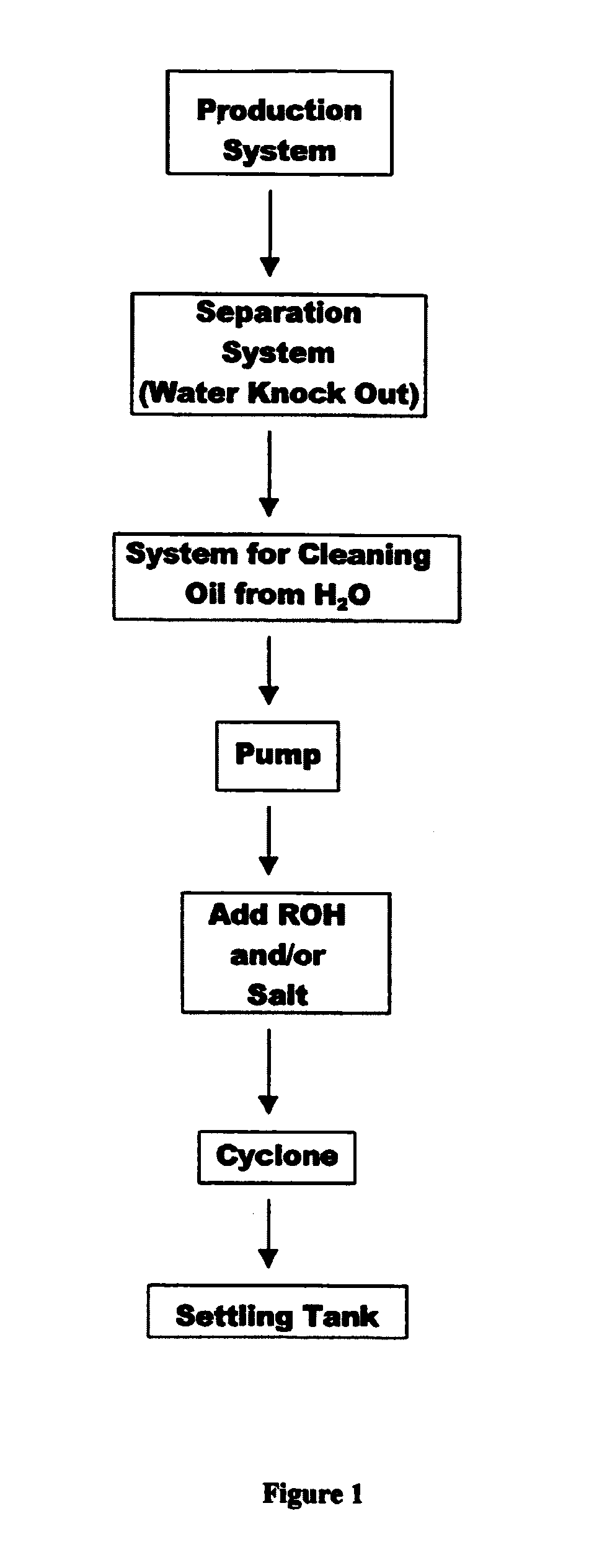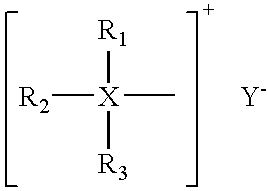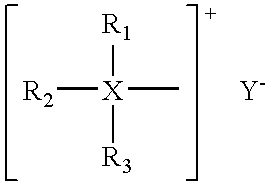Method for recovering water soluble surfactants
a technology of surfactants and water soluble surfactants, applied in solvent extraction, separation processes, wellbore/well accessories, etc., can solve the problems of increasing the collection of hydrates, not protecting against cooling, and hydrates have a tendency to occlude or block these pipelines or conduits
- Summary
- Abstract
- Description
- Claims
- Application Information
AI Technical Summary
Benefits of technology
Problems solved by technology
Method used
Image
Examples
example 1
[0073]2.04 grams of hexadecyltributylphosphonium bromide, hence called quaternary salt or more simply, quat, was added to a solvent blend consisting of 96.0 ml of water plus 4.0 ml of isopropanol at room temperature. The three compounds were miscible, providing a single, clear phase. A blend of sodium and calcium chlorides (70% NaCl, 30% CaCl2) was added to the previous mixture with results as listed in Table 1:
[0074]
TABLE 1Mixed Sodium / Calcium Salt Effects on Dissolved Quaternary SaltsNaCl / CaCl2Initial PhaseNumber ofConcentrationAppearanceFinal Phases1.94 gmClear13.99 gmClear16.29 gmCloudy2
[0075]Addition of approximately 6% normal salt to the ionic surfactant / water / isopropanol created an initially cloudy mixture which settled out into two clear phases. The top phase appeared to be principally isopropanol and contained dissolved solids at a level of 1.53 grams. The solids were principally ionic surfactant quaternary salts indicating that the procedure recovered approximately 75% of ...
example 2
[0076]The lower phase from Example 1 above, measuring about 96 milliliters, is separated from the upper phase which contained 75% of the quaternary salt and contacted with an aliquot of isoproponal measuring 4.2 milliliters, and contacted for 5 minutes and allowed to settle for 5 minutes into two phases under the influence of gravity or augmented gravity for a period of 10 minutes. The isopropanol (IPA) rich phase increases to 4.9 milliliters. Analysis for phophorous content by flame ionization detection indicates that the IPA phase contains 0.45 grams of quaternary inhibitor. The example clearly shows that a second extraction step would raise the recovery of the quarternary compound to over 96%.
example 3
[0077]A solution is prepared which contains the following constituents: 1.6 grams of hexadecyltributylphophonium bromide, 3.1 grams of IPA, 1.2 grams of NaCl and 3 grams of CaCl2, all dissolved in 96 grams of water. To this solution is added 4 grams of a salt mixture of sodium and calcium chlorides and 2 grams of IPA. The mixture is contacted for 5 minutes and allowed to settle into two phases. Phosphorus determination of the IPA-rich phase shows that it contains 1.4 grams of the inhibitor, resulting in an 87% recovery. A second extraction with IPA raises the recovery of the quaternary compound to 98%.
PUM
| Property | Measurement | Unit |
|---|---|---|
| temperature | aaaaa | aaaaa |
| pressures | aaaaa | aaaaa |
| temperatures | aaaaa | aaaaa |
Abstract
Description
Claims
Application Information
 Login to View More
Login to View More - R&D
- Intellectual Property
- Life Sciences
- Materials
- Tech Scout
- Unparalleled Data Quality
- Higher Quality Content
- 60% Fewer Hallucinations
Browse by: Latest US Patents, China's latest patents, Technical Efficacy Thesaurus, Application Domain, Technology Topic, Popular Technical Reports.
© 2025 PatSnap. All rights reserved.Legal|Privacy policy|Modern Slavery Act Transparency Statement|Sitemap|About US| Contact US: help@patsnap.com



